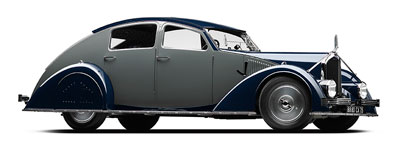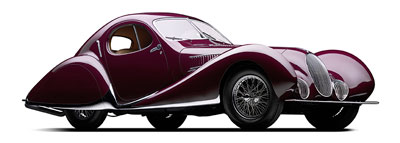by Shin Takei
Definition of Elegance and Beauty of a Bygone Era
When was the last time you immersed yourself in genuine elegance? We’re not talking about a luxury vacation at a five star resort or dining at a fine restaurant. Nor are we talking about attending a red carpet event, wearing the latest fashionable attire, or being invited to the Queen’s Diamond Jubilee. We’re talking about the Art Deco era of the 20’s and 30’s that epitomized elegance. While the world’s economy was on the decline, elegance was at its peak. Beautifully designed creations by artists and craftsmen were proliferating and luxury automobiles were hand built and assembled for the very few that could afford one. The entire period bore fruit to a decadent lifestyle enhanced by the backdrop of a dark depression.
The Mullin Automotive Museum celebrates this Art Deco movement, where art and technical innovation were integrated with industrial design. It showcases the hand-craftsmanship and mechanical precision that were applied with spectacular fashion to produce beautiful shapes on exquisite elegant automobiles.
It was Peter W. Mullin’s dream to create an environment for his collection of Pre-War French Art Deco styled cars. And like the cars, the museum is perfection in detail and execution. Having a lifelong enthusiasm for cars, Mullin’s collection is focused on cars from 1918 to 1941 and includes many artifacts and furniture from the period as well. The Museum formerly housed the car collection of the late Otis Chandler of LA Times fame, but has since gone through an extensive renovation. The rebuild set the highest quality standards and included an eco-friendly solar voltaic array on top of a sealed, white thermoplastic roof. Mullin recreated the Art Deco look of the Paris Auto Salon including columns, huge hanging light fixtures, and signs denoting each car marque. There are over 65 automobiles from the bygone era on display by Bugatti, Delage, Delahaye,
Hipano-Suiza, Talbot Lago, and Voisin. Some are flamboyant in design penned from the ateliers of coach builders and carrosserie like Chapron, Figoni et Falaschi, Gangloff, Labourdette, Letourneur et Marchand, Saoutchik, and Vanvooren.
In the back of the main Salon is a 90 foot diorama of a barn where cars in original condition provide a stark contrast to the restored beauties in the main display gallery. The space is over 50,000 square feet and adjacent to the museum foyer stands an elevator tower featuring an Art Deco style wrought iron enclosure leading up to the mezzanine. Mullin, who also raced many of his cars all over the world, has created a gallery of Grand Prix and Le Mans race cars in a casual setting. On the other side is Club Bugatti, an elegant lounge featuring an Art Deco bar and furniture designed by Ettore Bugatti himself.
In 1939, Ettore’s son Jean Bugatti died in an accident while testing a Type 57 but not before completing the chassis for a Type 64. The Mullin Automotive Museum in collaboration with Stewart Reed Design and Automobile Metal Shaping Company created a hand-formed aluminum body incorporating many of the concepts and original design from the archives. The newly bodied creation was exhibited to much fanfare at Quail, A Motorsport Gathering in Carmel Valley on August 17, 2012. This car as well as a new exhibit on Avions Voisin automobiles will be opening this fall at the museum.
Peter Mullin exhibits his collection at numerous Concours D’Elegance around the world and quite often the Best in Show is a battle of the titans. His main rival has been Ralph Lauren, the other guy with the splendid car collection (and some decent clothes). During the Art Deco period, the world was changing rapidly and going downhill, but for those who were the privileged and had the means, the finest in art, fashion, jewelry, objet d’art, furniture, and automobiles were available for those that wanted it. The Mullin Automotive Museum has gathered an impressive collection of that period and is a joy for any enthusiast to visit.

1938 Hispano Suiza Dubonnet Xenia
If the name Dubonnet sounds familiar, it belongs to Andre Dubonnet the maker of the famous elixir we all have tasted once in our lives. But little known is his passion for racing and fine automobiles. Together with Hispano-Suiza he commissioned the coach builder Saoutchik to build an aerodynamic body with sliding doors. Equipped with a pneumatic suspension way ahead of its time, the result was this futuristic car that looked like a spacecraft. The name Xenia was only to arouse curiosity, nothing more.
1934 Avions Voisin C-25 Aerodyne
With a sliding, disappearing sunroof and aerodynamic styling, this radial engined prototype was first showed at the Paris Auto Salon in 1934. Being an aircraft designer, Gabrielle Voisin concentrated on making his creations lightweight and quite unique amongst the swoopy lined trend of the era. This car won Best of Show at Pebble Beach Concours d’Elegance in 2011.
1938 Talbot Lago T150 SS ‘Goutte d’Eau’
Created by Carrosserie Figoni et Falaschi, the T150 SS was the ultimate expression of the “swoopy look” evident by its name which means “teardrop.” With diminishing pontoon fenders, this car defined the course of French Art Deco automobile design of the period. With Talbot Lago’s racing experience, the sporting character is evident in the design.
1936 Bugatti Type 57SC Atlantic
We covered a sister car of this owned by Ralph Lauren in our Summer 2011 issue. The lightweight magnesium alloy body was made without welding because that would cause a fire. A centrally located spine is riveted to hold it together. With very few examples made, it is one of the rarest and valuable automobiles in this collection.




